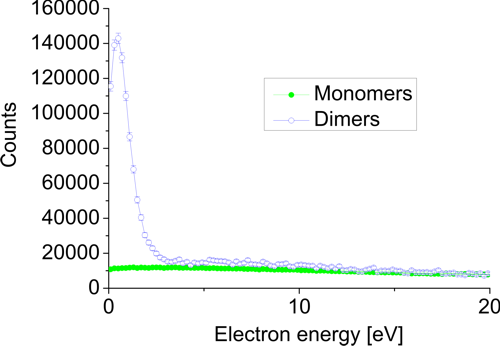Enhanced production of low energy electrons by alpha particle impact
|
We study the electron emission of Ne monomers and dimers after He+ ion impact ionization at a projectile energy of 162.5 keV/u. The electron energy distribution of the ionized Ne monomers is displayed by the green curve. Surprisingly, this behavior changes dramatically, when the ionized monomer is located in the close neighborhood of another neutral Ne atom (as realized in a Ne dimer). The blue curve shows an enhanced production of low energy electrons (0-3 eV) in ion/dimer collisions by a factor of 14.

This effect can be attributed to a mechanism known as the “Interatomic Coulombic decay” (ICD). In ICD the incoming He+ projectile ionizes one of the dimers Ne atoms by the removal of a 2s-electron. A 2p-electron of the same site fills the 2s-hole. The released excess energy is transferred to the neighboring atom where a 2p-electron with a low kinetic energy is emitted. More details can be found here: Enhanced production of low energy electrons by alpha particle impact Hong-Keun Kim, Jasmin Titze, Markus Schöffler, Florian Trinter, Markus Waitz, Jörg Voigtsberger, Hendrik Sann, Moritz Meckel, Christian Stuck, Ute Lenz, Matthias Odenweller, Nadine Neumann, Sven Schössler, Klaus Ullmann-Pfleger, Birte Ulrich, Rui Costa Fraga, Nikos Petridis, Daniel Metz, Annika Jung, Robert Grisenti, Achim Czasch, Ottmar Jagutzki, Lothar Schmidt, Till Jahnke, Horst Schmidt-Böcking, and Reinhard Dörner PNAS (2011) vol. 108, no. 29, 11821-11824 or http://dx.doi.org/10.1073/pnas.1104382108 |